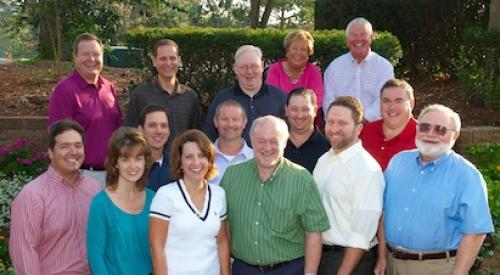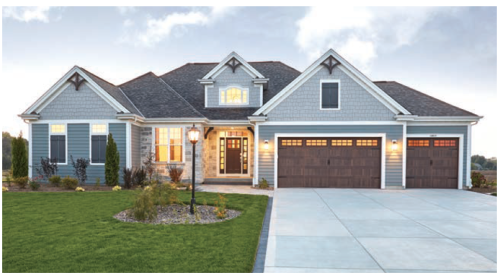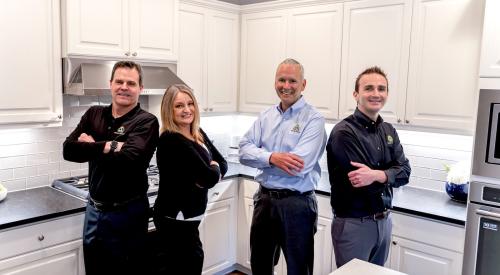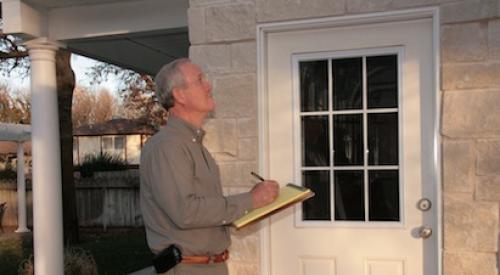Charles Morgan is no stranger to housing market downturns. As a third-generation builder who has spent the better part of the past 33 years building his company from scratch into one of Memphis’ largest semi-custom home builders, Morgan successfully navigated Vintage Homes through tough times in the early 1980s, mid-1990s, and early 2000s. But the sub-prime mortgage crisis and the ensuing economic recession between 2006 and 2008 had rocked Vintage’s business to the core. Almost overnight, the market for high-end move-up homes in the Memphis area all but dried up, and Morgan was forced to rethink the business model that had served his company well for more than three decades.
“In early 2006, as our sales started falling, I became very concerned about the real estate market for high-end, semi-custom homes in our area,” says Morgan, who serves as the company’s president and CEO. “We began to look for a business model that would serve customers who would always be in need of a home.”
Less than 12 months later, Vintage Homes had completely remade itself as a builder focused solely on first-time buyers. The shift from building $300,000-plus semi-custom homes to starter homes with price points as low as $85,000 was a dramatic one for Vintage that presented a whole new set of challenges for the team. Yes, the pool of potential customers would expand greatly, but the starter-homes business would be much more competitive and price-sensitive than the move-up market. It meant competing with not only other production builders, but also the resale market, especially deeply discounted foreclosures and short sales. Then factor in the financial hurdles that many first-time buyers face, and it was clear that the transformation would be an uphill battle.
NHQ Bronze Award
Vintage Homes
Memphis, Tenn.
Founded: 1979
Markets: Memphis metro area and northern Mississippi
2011 revenue: $14.4 million
2011 closings: 97Quality Best Practices:
• “Starts” meetings — The builder’s primary mortgage lender partners participate in their twice-weekly “starts meetings,” where they provide a near-real-time update on all the Vintage buyers in their processing pipeline.
• Credit repair services — Vintage has two full-time staff members that are dedicated to helping potential buyers improve their credit score and financial situation. The program accounts for about half of their buyers.
• OFIs (opportunity for improvement) — All members of the team, including trades and suppliers, are encouraged to submit ideas for improvement, which are closely vetted by managers.
• Business technology tools — Vintage is adopting the latest technologies and systems to improve their products and processes. For example, BIM software allows the builder to more accurately estimate the cost of their plans and offer customers virtual walkthroughs.
“After a while, we realized that the challenges we faced in early 2006 were nothing when compared to the hurdles we faced in getting customers approved for their loans, especially for those coming out of rental apartments,” says Morgan. “It’s still our top challenge.”
Rayco model comes to Memphis
Morgan knew he had to establish a business model that was nearly bulletproof to have a chance at succeeding in the starter-homes business. For guidance, he reached out to industry consultants at Next Solutions Inc., Laguna Beach, Calif., namely Douglas Wilson, Roxanne Musselman, and Jack Robinson — the latter who pioneered several home-building best practices, including “even-flow” construction, while heading up the former Rayco company (Rayco was acquired by KB Home in 1996). Morgan’s goal was to bring the “Rayco model” to Memphis.
“Rayco was a well-oiled machine,” says Morgan. “For instance, they perfected the model for taking a customer who would normally rent with a 580 credit score and turning them into a homeowner, using credit repair and other approaches.”
Following the Rayco model, Vintage Homes established their Homebuyers Connection, a credit repair and financial consulting service that guides serious prospects in overcoming credit challenges. The builder brought in a credit and finance expert, Craig Cline, to head up the program and saw success almost immediately. In 2011, Homebuyers Connection accounted for roughly half of the builder’s buyers and the program is tracking at a similar rate this year, according to CFO Odus Wiley.
“It’s been a huge success for us,” says Wiley. “We run into so many people who believe they will never become homeowners. It’s a great feeling to see the look on their faces when we show them there is a way.”
Vintage also maintains strong ties with its primary mortgage lender partners and invites them to participate in their twice-weekly “starts meetings.” There, the lenders provide a near-real-time update on all the Vintage buyers in their processing pipeline and work through issues that may arise.
“There’s a huge benefit to having our key lenders in the room,” says Cline. “We’re able to quickly work through any issues as a team. We’ve even had lenders trade applicant folders during situations when one institution feels like they can’t get a buyer approved and another feels they can. Our lenders are truly part of the team.”
Morgan and his team also learned Rayco’s approach to market research, which enables the builder to zero in on land in areas that are prime for first-time buyers. “Mostly through MLS mining, we’re able to divide the market into multiple sections and look for people who are candidates for a starter home and where they would want to reside,” says Morgan. The sweet spots are typically dominated by apartments, however, Vintage is even able to drill down to the neighborhood level to locate pockets of single-family detached rentals.
Most bang for the buck
When it comes to product, Vintage’s strategy is to stand out from the competition by offering the most value in the market. Its competitive positioning is to be $10,000 less than the competition or 500 square feet larger. To be able to offer more for less and still squeeze out a profit, the company relies on its experienced management team, strong relationships with its trades and suppliers, and quality processes and policies to maintain cost controls, maximize value, and create a great experience for the customers.
Vintage’s OFI (opportunity for improvement) program, for example, involves every member of the team, as well as trades and suppliers — any one of which can submit an idea. Each and every OFI is carefully evaluated by the company’s key management team and, if it aligns with the builder’s overall mission, is implemented. OFIs include everything from the way lumber is delivered to the site to ideas for improving community signage to new house plan concepts.
The builder is also leaning on the latest technologies and systems to improve their products and processes. They’re just getting started with using BIM (building information modeling) software to provide more accurate cost estimates on their plans and to offer customers virtual walkthroughs. Also, they recently adopted the BuilderMT platform for workflow management and have equipped all field employees with tablet PCs to help them stay on top of schedules, workflow, and issues in the field.
“Because of the technology, we’re getting more eyes on the problems a lot quicker,” says Morgan.













